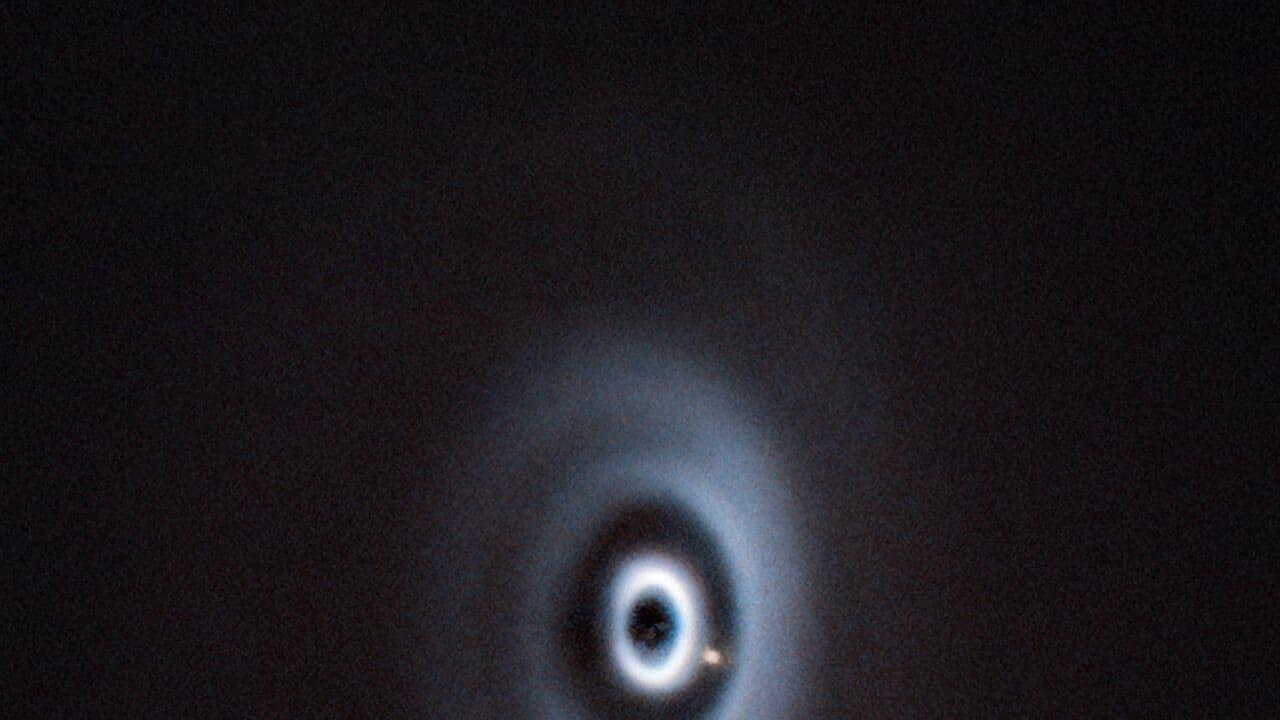Science
Astronomers Capture First Image of Forming Planet WISPIT 2b

For the first time, astronomers have successfully captured an image of a forming planet, known as WISPIT 2b, orbiting a young star. This significant discovery provides a rare opportunity to observe the early stages of planetary formation, shedding light on how gas giants like Jupiter and Saturn may have developed. The research was conducted by a collaborative team from Leiden University, the University of Galway, and the University of Arizona.
WISPIT 2b is situated within a vast disk of gas and dust, which extends nearly 380 times the distance between the Earth and the Sun. This disk consists of concentric rings surrounding the star, serving as the fundamental material from which planets emerge. Estimated to be only 5 million years old, WISPIT 2b is still in its infancy compared to the 4.5 billion-year history of Earth. The planet is approximately five times the size of Jupiter and continues to glow due to its active accumulation of gas, contributing to the formation of its atmosphere.
Astronomers utilized the European Southern Observatory’s Very Large Telescope (VLT) in Chile, one of the most advanced facilities globally, to capture the planet in near-infrared light, akin to what one would see using night-vision goggles. Further validation of the discovery came when researchers from the University of Arizona confirmed the presence of WISPIT 2b in visible light.
A Remarkable Discovery in Planetary Science
This marks only the second instance where scientists have been able to directly image a planet at such an early developmental stage around a Sun-like star. The uniqueness of this observation is enhanced by the fact that WISPIT 2b is the first confirmed planet found within a multi-ringed disk. This discovery allows researchers to examine how young planets interact with the disks from which they are born.
Dr. Christian Ginski from the University of Galway expressed excitement at the initial sighting of the disk, stating, “When we saw this beautiful multi-ringed disk for the first time, we had to check if there was a planet within it – and sure enough, there it was.” This finding not only contributes to our understanding of planetary formation but also highlights the significance of collaboration in scientific research.
Young Researchers Lead the Way
The breakthrough was achieved as part of a five-year project focused on the search for giant planets around young stars. Interestingly, a team of early-career PhD and graduate students led the analysis, transforming what began as a routine observation into a groundbreaking discovery. Richelle van Capelleveen, a PhD student at Leiden University and lead author of the study, described the experience as extraordinary: “Discovering this planet was an amazing experience. We didn’t expect to find such a spectacular system. This will likely become a benchmark for studying planet formation.”
The discovery of WISPIT 2b is expected to offer insights into the diversity of exoplanet systems – planets that orbit stars beyond our solar system. By studying this unique system, astronomers aim to understand the factors that lead to the formation of giant planets like Jupiter compared to smaller, rocky planets like Earth.
For now, the image of WISPIT 2b, glowing within its birth disk, stands as one of the clearest “baby pictures” of a planet ever captured. As one researcher aptly noted, “Sometimes you forget the big picture. But then you realize – we just captured a planet being born.” This discovery opens new avenues for exploration in the field of planetary science, promising to enhance our understanding of how planets form and evolve across the universe.
-

 Science3 months ago
Science3 months agoToyoake City Proposes Daily Two-Hour Smartphone Use Limit
-

 Top Stories3 months ago
Top Stories3 months agoPedestrian Fatally Injured in Esquimalt Collision on August 14
-

 Health3 months ago
Health3 months agoB.C. Review Reveals Urgent Need for Rare-Disease Drug Reforms
-

 Technology3 months ago
Technology3 months agoDark Adventure Game “Bye Sweet Carole” Set for October Release
-

 World3 months ago
World3 months agoJimmy Lai’s Defense Challenges Charges Under National Security Law
-

 Lifestyle3 months ago
Lifestyle3 months agoVictoria’s Pop-Up Shop Shines Light on B.C.’s Wolf Cull
-

 Technology3 months ago
Technology3 months agoKonami Revives Iconic Metal Gear Solid Delta Ahead of Release
-

 Technology3 months ago
Technology3 months agoApple Expands Self-Service Repair Program to Canada
-

 Technology3 months ago
Technology3 months agoSnapmaker U1 Color 3D Printer Redefines Speed and Sustainability
-

 Technology3 months ago
Technology3 months agoAION Folding Knife: Redefining EDC Design with Premium Materials
-

 Business3 months ago
Business3 months agoGordon Murray Automotive Unveils S1 LM and Le Mans GTR at Monterey
-

 Technology3 months ago
Technology3 months agoSolve Today’s Wordle Challenge: Hints and Answer for August 19









